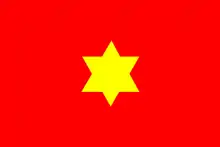People's Anti-Imperialist Association
People's Anti-Imperialist Association[lower-alpha 1] (Chinese: 民众反帝联合会; pinyin: Mínzhòng Fǎn Dì Liánhé Huì; Wade–Giles: Minchung Fan Ti Lienho Hui) was a political party in Xinjiang, China during the rule of Sheng Shicai, between 1935 and 1942.
People's Anti-Imperialist Association 民众反帝联合会Mínzhòng Fǎn Dì Liánhé Huì | |
|---|---|
 Flag of Xinjiang based on the flag of the Soviet Union representing the Six Great Policies | |
| President | Sheng Shicai |
| Founder | Sheng Shicai |
| Founded | 1 August 1935 |
| Dissolved | April 1942 |
| Headquarters | Ürümqi, Xinjiang |
| Newspaper | Anti-Imperialist War Front |
| Youth wing | Xinjiang's Youth |
| Women's wing | Xinjiang's Women |
| Membership (1939) | 10,000 |
| Ideology | Six Great Policies |
| Political position | Left-wing |
History
The People's Anti-Imperialist Association was founded by Sheng Shicai in Ürümqi on 1 August 1935. The propaganda outlet of the Association was the Anti-Imperialist War Front. The Sinkiang's Youth and the Sinkiang's Women served as the Association's youth and women's wing respectively. The Association saw a large increase in membership. In 1935 it had 2,489 members, in 1937 the membership grew to 5,281, and in 1939 the Association's membership rose to 10,000.[4] The membership was nationally diverse, and included Han, Hui and various Turkic peoples.[5]
The ideology of the People's Anti-Imperialist Association were the "Six Great Policies", issued by Sheng in December 1934.[6] The Policies guaranteed his previously enacted "Great Eight-Point Manifesto"[7] and included "anti-imperialism, friendship with the Soviet Union, racial and national equality, clean government, peace and reconstruction".[6][7] Sheng referred to them as "a skillful, vital application of Marxism, Leninism, and Stalinism in the conditions of the feudal society of economically and culturally backward Sinkiang".[8] They served as the ideological basis of Sheng's rule.[9] With the proclamation of the Six Great Policies, Sheng adopted a new flag with a six-pointed star to represent these policies.[10]
With Sheng's rapprochement with the Central government, the Kuomintang spread throughout the province, replacing the People's Anti-Imperialist Association,[11] which was disbanded in April 1942.[12]
Notes
Footnotes
- Rahman 2005, p. 38.
- Chaudhuri 2016, p. 59.
- Brophy 2016, p. 256.
- Chan 1983, p. 378.
- De Cordier 2016, p. 61.
- Clarke 2011, p. 33.
- Mansfield 1945, p. 3735.
- Sheng 1939.
- Chan 1983, p. 377.
- Brophy 2016, p. 255.
- Jacobs 2011, p. 350.
- Dallin 1948, p. 362.
References
Books
- Brophy, David (2016). Uyghur Nation. Cambridge, MA: Harvard University Press. ISBN 9780674660373.
- Chaudhuri, Debasish (2016). "China's Policy in Xinjiang, 1948–78". In Warikoo, K. (ed.). Xinjiang – China’s Northwest Frontier. Abingdon-on-Thames: Routledge. ISBN 9781317290292.
- Clarke, Michael E. (2011). Xinjiang and China's Rise in Central Asia – A History. Abingdon-on-Thames: Taylor & Francis. ISBN 9781136827068.
- Dallin, David J. (1948). Soviet Russia and the Far East. New Haven, CT: Yale University Press. ISBN 978-0208009968.
- Jacobs, Justin Matthew (2011). Empire besieged: the preservation of Chinese rule in Xinjiang, 1884–1971. San Diego, CA: University of California, San Diego. ISBN 9781124814070.
- Mansfield, Mike (1945). "Outer Mongolia and Sinkiang". Congressional Record: Proceedings and Debates of the 79th Congress First Session. 91. Washington D. C.: U.S. Government Printing Office.
- Rahman, Anwar (2005). Sinicization Beyond the Great Wall: China's Xinjiang Uighur Autonomous Region. Kibworth Beauchamp: Troubador Publishing Ltd. ISBN 9781904744887.
Journals
- Chan, F. Gilbert (1983). "Sheng Shih-ts'ai's reform programs in Sinkiang: idealism or opportunism?". Journal of Modern History. 12: 365–385.
- De Cordier, Bruno (2016). "International aid, frontier securitization and social engineering: Soviet-Xinjiang development cooperation during the Governorate of Sheng Shicai (1933–44)". Central Asian Affairs. 3: 49–76.
- Nyman, Lars-Erik (1991). "Sinkiang 1934-1943: Dark decade for a pivotal puppet". Cahiers du Monde Russe. 32: 97–105.
Websites
- Sheng, Shicai (1939). "Translation of a 4 January 1939 Letter of Governor Sheng Shicai to Cdes. Stalin, Molotov, and Voroshilov". Woodrow Wilson International Center for Scholars. Retrieved 24 November 2017.